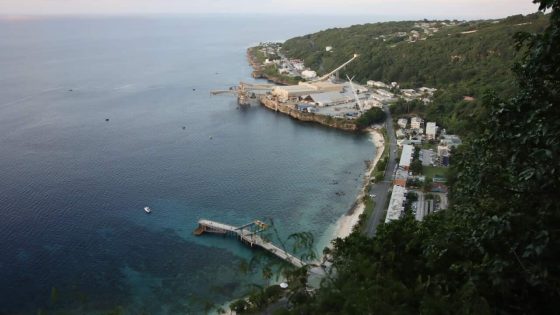And some may even recall the heady days of its casino, which generated more than $5 billion a year in profits for four years during the 1990s.
Christmas Island’s identity
Twenty-two per cent of the island’s inhabitants are of Chinese ancestry.
Parts of the Christmas Island community tossing noodles for good luck at a Lunar New Year event in February 2024. Source: SBS News / Christopher Tan
Despite being detached from the mainland, Christmas Island has a Western Australian postcode, and the federal government has the power to enforce state-level laws in addition to federal laws.
Even though the island formally became part of Australia in 1958, residents were not permitted to vote until 1984.
Immigration detention centre
The Christmas Island Detention Centre was built at a cost of $396 million with hundreds of millions of dollars per year spent on Australian immigration officials and Navy and Australian Border Force personnel to operate the facility.

The empty Christmas Island immigration detention centre in February 2024. Source: SBS News / Christopher Tan
It became notorious for its protests and riots, most notably in October 2015 after Kurdish-Iranian inmate Fazal Chegani Nejad escaped. His dead body was found close to the centre’s fence with a ligature compression of the neck.
Despite its stigma, the detention centre became an important stimulus to the island’s economy, increasing local employment and spending.
“The facility on Christmas Island can be reactivated at short notice, if needed, to alleviate pressures within the mainland Immigration Detention Network.”
Phosphate mining
It remains the island’s most valuable resource and source of income for households.

Phosphate mining has been underway for over a hundred years on Christmas Island and remains the island’s main economic driver. Source: SBS News / Christopher Tan
Phosphate mining generates approximately 280 full-time jobs, representing 40 per cent of the island’s total labour force.
CIP has an application to increase its current 18.1 hectares for extraction, but locals believe there is very little chance of it being approved due to environmental impacts.
An abandoned casino
It’s been 26 years since the dice were last rolled at what was once the world’s most profitable gaming floor.

Christmas Island’s casino once generated over $5 billion a year in profits. Source: SBS News / Christopher Tan
The opening of the Christmas Island Resort in 1993 provided, for the first time, a true tourism base for the island.
“It employed 400 people full time, there were flights five days a week, and it grew the population from 800 to 2,700 in less than five years.”

When the Christmas Island Casino operated, the facility included 43 slot machines and 23 gambling tables. Source: SBS News / Christopher Tan
The resort sits on a 47-hectare block of land with a crown lease not expiring until 2088.
It consists of 156 guest rooms and suites, including a restaurant, nightclub and swimming pool and last operated in February 2014 to house detention centre workers.
What’s next for Christmas Island?
“We believe the disturbed land from mining, could be put to good use for agriculture and horticulture,” he said.

Gordon Thomson has been Christmas Island’s Shire president since 2003 and says the island has an agricultural future. Source: SBS News / Christopher Tan
Last December, the shire took its Christmas Island-Singapore strategy to Canberra to meet with representatives from the prime minister’s office.
Thomson says that, after talks with tertiary institutions in Singapore, the shire has plans to repurpose the island’s sports hall into a sustainability hub for research.
“The next stage is that we are hoping the Commonwealth will advocate for us, to tell Singapore this is (also) part of Australia’s plan … and not just the shire’s.”
What about tourism?
Destination marketing manager Sarah Coote says the island’s natural attractions are a big drawcard.

The over 100 million red crabs living on Christmas Island are one of the main drawcards for tourism each year. Source: SBS News / Christopher Tan
“It’s a place where it is not overdeveloped and so nature takes centre stage,” she said.
The coverage of 277,016 square metres of ocean and sea floor provides protection for more than 680 species of fish in the region; opportunities for recreational activities like boating, diving and snorkelling; as well as in investment in educational research.

The swimming pool at the Christmas Island Resort sitting derelict. Source: SBS News / Christopher Tan
Coote says the certainty has enabled the association to plan forward and ramp up its social media presence.
“It means that people can enjoy this place for generations to come, where we have some of the best diving spots, and some of the most incredible clear (warm) water all year round on the planet,” she said.
Why are people staying?
“The neighbours here are very nice. Sometimes if they cook, and when there is a special occasion, they will always cook for me.”

Christmas Island couple Araya Thongson and Kim (Ya-Ju) Sung. Source: SBS News / Christopher Tan
Sung was one of a number of others who lost their jobs when the detention centre was emptied.
He is one of a few remaining life-long residents, having stayed and opened the island’s first and only Malay Muslim convenience shop.

Zainal Abdul Majid opened the island’s first and only Malay Muslim convenience shop. Source: SBS News / Christopher Tan
Majid, who also previously worked at the mine, hopes that operations will continue beyond 2034.
“Nothing quite beats this island life.”
Source Agencies




